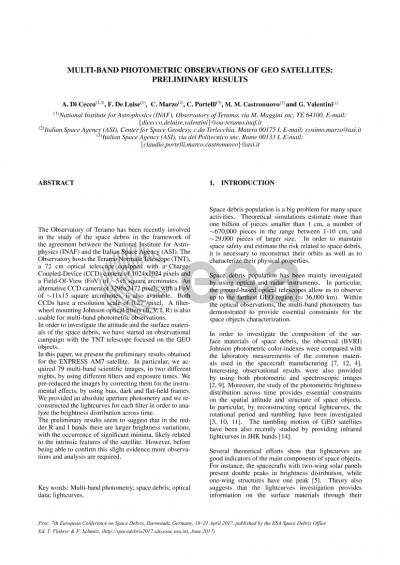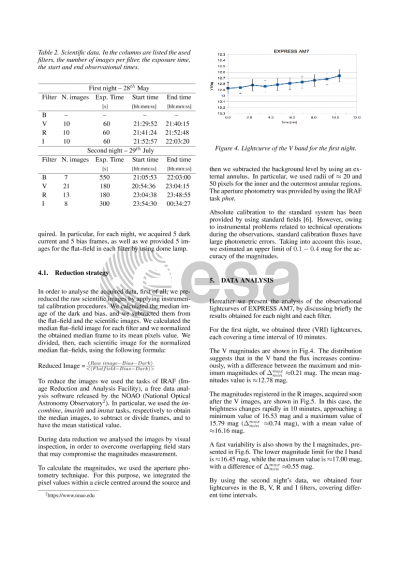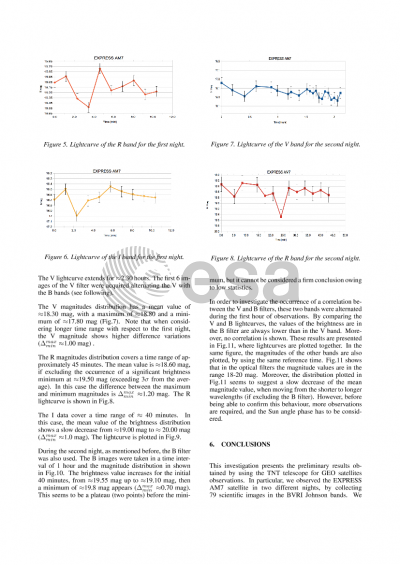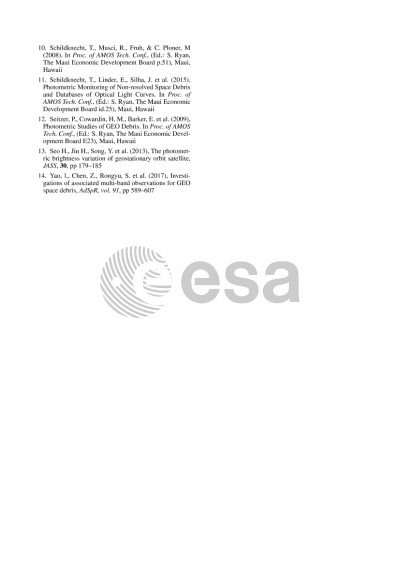Document details

Abstract
The analysis of the photometric lightcurves has been demonstrated to provide essential constraints on the rotational period and tumbling of space objects (Schildknecht et al. 2015, AMOS Conf. Proc. 2014, p. 51; Choi et al. 2016, JASS, 33, 127), as well as on the main components of spacecrafts (Jin et a. 2011, AMOS Conf. Proc. 2011, p.13). The investigation of the lightcurves at different wavelengths also provides information on the surface materials of an orbital object through the analysis of the reflectivity (Murtazov 2013, AJMP, 2, 282). In this context, recent results have been provided by using both BVRI optical (Cardona et al. 2016, AdSpR, 58, 514) and JHK infrared bands (Yao et al. 2017, AdSpR, 91,589). In this paper, we present the first analysis conducted by using the multi-band photometric data of the Teramo
Normale Telescope (TNT) that has been recently involved in the study of space debris in the framework of the agreement between the National Institute for Astrophysics (INAF) and the Italian Space Agency (ASI).
The TNT telescope is a small class optical telescope of ?72 cm diameter, equipped with a CCD camera of 1024x1024 pixels and a Field-Of-View (FoV) of ?5x5 arcminutes; an alternative CCD camera of 3296x2472 pixels with a FoV of ?11x15 square arcminutes is also available. Both CCDs have a resolution scale of 0.27''/pixel. A filter-wheel mounting the Johnson optical bands B, V, R and I is usable for multi-band observations. We acquired 79 scientific images of a GEO satellite, i.e. EXPRESS AM7, in two different nights, by using different
exposure time (30-300 s) and filters. We pre-reduced each observation for the instrumental effects by correcting for bias and dark currents, as well as for the flat-field. We provided an aperture photometry and we extracted the magnitudes in order to reconstruct the lightcurves. The analysis of the lightcurves shows that during the same night the brightness variations extent within the range of ?1-1.2 mag in the same band. However, when comparing different nights, the lightcurves show a different behaviour. In particular, for each filter, the average
value of the magnitudes changes significantly between the two nights, approaching the maximum discrepancy (?6 mag) for the V band. To explain this discrepancy, more data and investigations are certainly required. Of particular interest is the fact that, in the first night, the R an I bands present strong brightness variations with the occurrence of significant minima. The R filter also presents a strong minimum during the second night, suggesting a brightness dependence of the object in the redder bands. The magnitudes distribution seems also to suggest a slow decrease of the mean value when moving from the shorter to the longer wavelengths (if excluding the B filter). However, more investigations are required and external lightning conditions (such as the Sun phase angle) have to be considered, before to be able to impose firm constraints.
Preview








